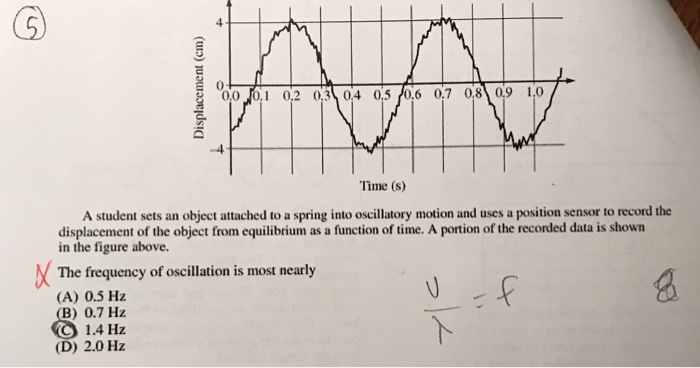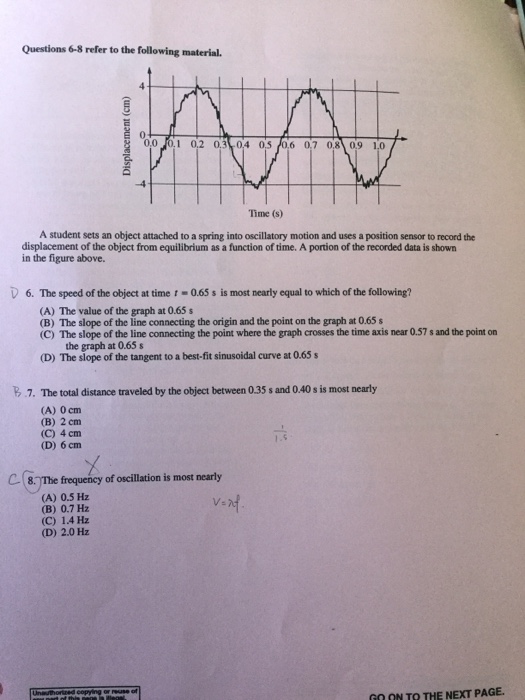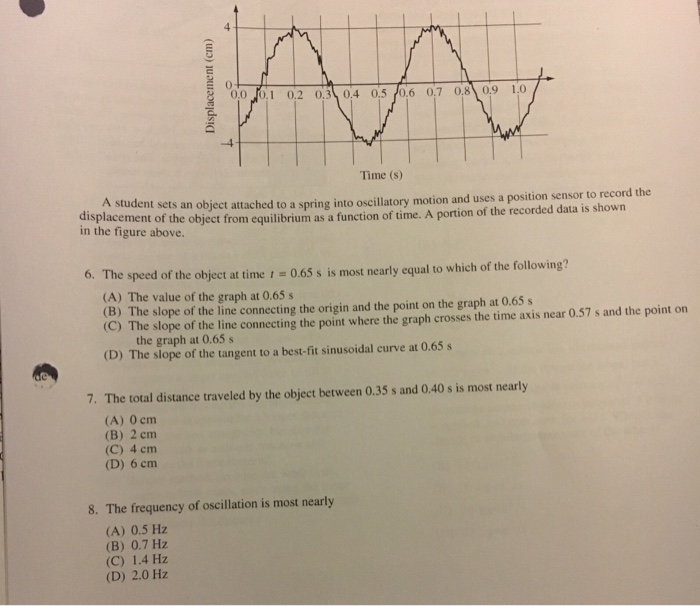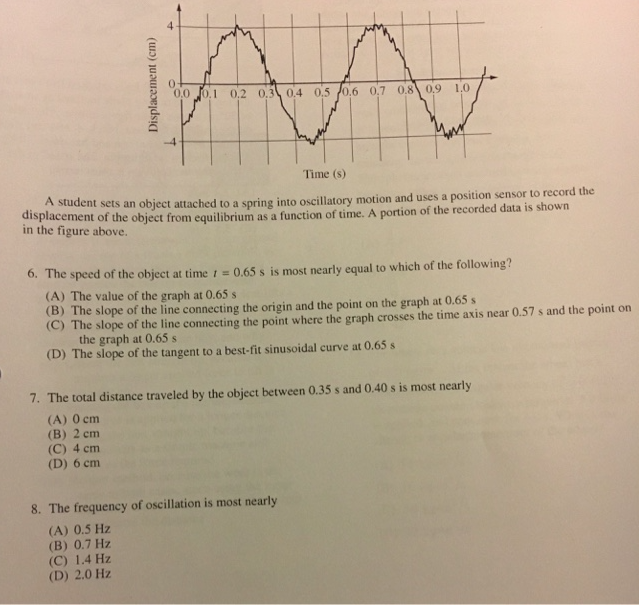A portion of the recorded data is shown in the figure. The student should attach the rubber band to the stand and the mass to the rubber band.

Solved 00 J0 1 0 2 0 35 0 4 05 0 6 0 7 0 8 09 1 0 Time S A Chegg Com
By what factor is the frequency of oscillation changed.

. A student sets an object attached to a spring into oscillatory motion and uses a position sensor to. As the drawing shows each spring is attached between the ceiling and th bj t B h h d h i t t hthe object. A student sets an object attached to a spring into oscillatory motion and uses a position sensor to record the displacement of the object from equilibrium as a function of time.
The student would need the unknown mass the rubber band a stand and a timer. B Determine the period of the spring-block oscillator. When displaced from equilibrium the object performs simple harmonic motion that has an amplitude X and a period T.
The frequency of oscillation is most nearly. Where T is the period m is the mass of the object attached to the spring and k is the spring constant of the spring. A 0500-kg object attached to a spring with a force constant of 800 Nm vibrates in simple harmonic motion with an amplitude of 100 cm.
The object is now released from rest with an initial position of x i. B If the spring has a force constant of 100 textrm Nm and a 025-kg-mass object is set in motion as described find the amplitude of the oscillations. An object is attached to a spring and its frequency of oscillation is measured.
Now the student can use the equation T2π m k to find the unknown mass. A portion of the recorded data is shown in the figure above. A portion of the recorded data is shown in the figure above.
A student sets an object attached to a spring into oscillatory motion and uses a position sensor to record the displacement of the object from equilibrium as a function of time. Their greater inertia means that it takes more time to complete a cycle. Physics questions and answers.
An object attached to a spring sliding on a frictionless surface is an uncomplicated simple harmonic oscillator. You release the object from rest at the springs original rest length. A portion of the recorded data is shown in the figure above.
A student sets an object attached to a spring into oscillatory motion and uses a motion detector to record the velocity of the object as a function of time. Feb 28 2022 0926 AM. 7The total distance traveled by the object between 035 s and 040 s is most nearly.
The object oscillates back and forth in what we call simple harmonic motion in which no energy is lost. The equation can be interpreted to mean that more massive objects will vibrate with a longer period. 001 02 0304 05 06 07 009 L0 Time s A student sets an object attached to a spring into oscillatory motion and uses a position sensor to record the displacement of the object from equilibrium as a function of time.
Then pull the mass down to set it into SHM and time 10 cycles. A horizontal force of 200 N is required to hold the object at rest when it is pulled 0200 m from its equilibrium position the origin of the x axis. The frequency of oscillation is most nearly.
A Draw a free body diagram for the block at t0. We have an object attached to a spring. The spring stretches by 0160 m.
A Show that the spring exerts an upward force of 200 mg on the object at its lowest point. A The maximum value of its speed and acceleration b The speed and acceleration when the. Question 10 inn -10 10 11 12 00 01 02 03 04 05 06 07 08 09 Time s A student sets an object attached to a spring into oscillatory motion and uses a motion detector to record the velocity of the object as a function of time.
A portion of the recorded data is shown in the figure above. Select all that apply. By how much does each spring stretch.
Hookes Law states that. The block is now displaced 15 centimeters and released at time t0. The object is on a horizontal frictionless surface.
A portion of the data is shown in the figure above. We move the object so the spring is stretched and then we release it. The spring is then cut into two identical springs of 50 coils each.
Then another object is connected to the first object and the resulting mass is four times the original value. The stiffer the spring is the smaller the period T. Order to extend a spring by an amount x from its previous position one needs a force F which is determined by F kx.
A student sets an object attached to a spring into oscillatory motion and uses a position sensor to record the displacement of the object from equilibrium as a function of time. A spring of spring constant 40 Nm is attached to a fixed surface and a block of mass 025 kg is attached to the end of the spring sitting on a frictionless surface. Up to 24 cash back A 04 kg object is attached to a horizontal spring undergoes SHM with the total energy of.
Divide that time by 10 to calculate the period. The student is now given an object with an unknown mass and is asked to use the. A student sets a 025 kg object into simple harmonic motion on a horizontal frictionless.
An object is attached to the lower end of a 100-coil spring that is hanging from the ceiling. FS kx 91 Here k is the spring constant which is a quality particular to each spring and x is the distance the spring is stretched or compressed. The acceleration of the object at time t07 s is.
The objects maximum speed occurs as it passes through equilibrium. The total distance traveled by the object between 035 s and 040 s is most nearly. A portion of the recorded data is shown in the figure below.
A portion of the recorded data is shown dent in the figure above. Spring Simple Harmonic Oscillator Spring constant. And springs with a greater spring constant stiffer springs have a smaller period.
A 200-kg object is attached to a spring and placed on a horizontal smooth surface. At what time does the object have the greatest upward net force. At what time s does the object have a maximum kinetic energy.
A student sets an object attached to a spring into oscillatory motion and uses a position sensor to record the of the object from equilibrium as a function of time. A student sets an object attached to a spring into oscillatory motion and uses a motion detector to record the velocity of the object as a function of time.

Solved 0 0 0 J0 1 0 2 0 3 0 4 0 5 0 6 0 7 0 8 0 9 1 0 4 Chegg Com

Solved 0 01 0 2 0 3 04 05 0 6 0 7 08 09 1 0 Time S A Stu Chegg Com

Solved Questions 6 8 Refer To The Following Material 0 00 1 Chegg Com

0 Comments